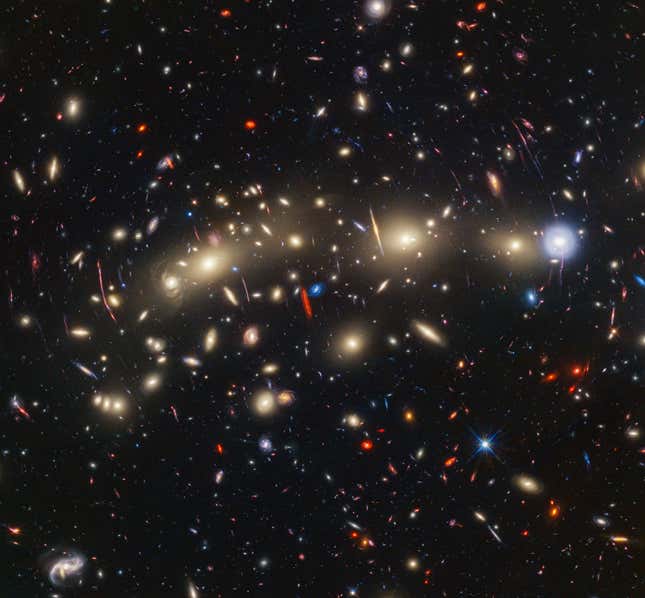It’s not yet December, but NASA is already in a festive mood: the Webb and Hubble space telescopes recently imaged MACS0416, a pair of colliding galaxy clusters 4.3 billion light-years from Earth that is bedecked in sparkling lights.
The image combines visible and infrared light, the respective wheelhouses of Hubble and Webb, to create a sweeping view of the colliding clusters. The Webb observations were taken as part of the Prime Extragalactic Areas for Reionization and Lensing Science, or PEARLS, program, and the Hubble data was collected as part of the Frontier Fields program, which began in 2014.
Advertisement
“We are building on Hubble’s legacy by pushing to greater distances and fainter objects,” said Rogier Windhorst, an astronomer at Arizona State University and principal investigator of PEARLS, in a Space Telescope Science Institute release. “The whole picture doesn’t become clear until you combine Webb data with Hubble data.”
Advertisement
While light at visible wavelengths means (perhaps obviously) our eyes can see it, infrared light is another matter. Webb is designed to image light beyond the red end of the electromagnetic spectrum, so Webb image processors have to assign visible light wavelengths to those otherwise invisible sources. In the new image, the bluer galaxies are nearer to us and easier seen by Hubble, while the redder galaxies are more distant and best seen by Webb.
Advertisement
While Hubble has been in operation for over 30 years, Webb only began its science imaging last July. You can see some of the best Webb images from its first year here.
Two papers detail aspects of the image. One, published in Astronomy and Astrophysics, describes the “extremely magnified monster star” nicknamed Mothra, after the fictional monster that features prominently in the Godzilla franchise. The other paper is accepted for publication in The Astrophysical Journal and is currently hosted on the preprint server arXiv; that work details 14 transient objects seen in the galaxy cluster. These transients are objects that vary in their observed brightness over time, causing the smattering of colors to twinkle in the eye of a telescope.
Advertisement
“We’re calling MACS0416 the Christmas Tree Galaxy Cluster, both because it’s so colorful and because of these flickering lights we find within it. We can see transients everywhere,” said Haojing Yan, an astrophysicist at the University of Missouri in Columbia and lead author of one of the papers, in the same release.

Advertisement
Twelve of the transients spotted are too faint and red for Hubble to see, so the Webb data was critical in getting a more complete image of the field. The researchers believe the other two transients are supernovae—vast explosions that occur at the end of a star’s life.
The star nicknamed Mothra is located in a galaxy that existed about three billion years after the Big Bang. The research team believes that the monster star is probably in a binary system with another supergiant star, which the team has fittingly nicknamed Godzilla. Mothra is anywhere between 10,000 and one million times our Sun’s mass, and may hint at the nature of dark matter.
Advertisement
In their paper, the team stated that axionic dark matter models (which focus on axions, a theoretical particle named for a detergent) are consistent with their observations in certain mass ranges for the axion. Earlier this year, another case of extreme gravitational lensing boosted the case for axionic dark matter.
As Webb and Hubble continues their investigation of the cosmos, our understanding of dark matter, the universe’s evolution, and the myriad objects that compose the cosmos will come into sharper relief. Their data—as well as the observations of other telescopes, like the nascent Euclid Space Telescope—will help us understand the makeup of the cosmos.
Advertisement
More: With Euclid’s First Dazzling Images, Webb Finds a Worthy Rival in Deep Space
Services Marketplace – Listings, Bookings & Reviews